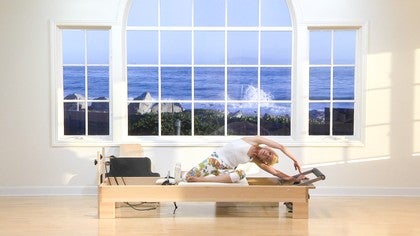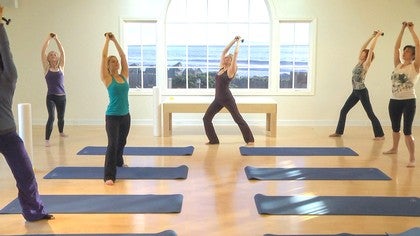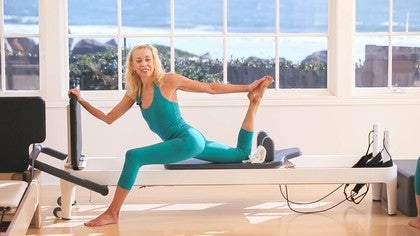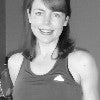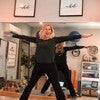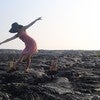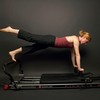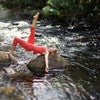Description
About This Video
Transcript
Read Full Transcript
Welcome to Palladio's anytime. I'm Elizabeth Larkam. Delighted to be with you to work on an exercise sequence for the reformer will make quite a bit of jumping practice in this reformer program. Not exclusively jumping but jumping. We'll be woven in with a mobility for the spine, specifically mobility for the thoracic spine, lots of opportunity to practice your fascia oriented training. Now, Fascia oriented training. You can read all about it on the website. Fascia, fitness dot d for a Germany.
Not to confuse this program with Fascia fitness. Don't go there, but this is fascia oriented training in the context of the reformer. Here we go. I have three red springs on the heavier setting, attaching the carriage slide on down so your sitting bones go off the edge of the carriage and then come to lie on your side and roll to your back. So here you are on your back adjusting your hair clip, your mic box, just getting everything organized. Now you're going to have the loops around your thighs. This may be more comfortable, easier with the double loops.
However, if you just have single loops, don't worry, they don't go all the way up your thigh just above your knee. Stand into this loop and here you are. Last sowing the new leg. Now as you inhale, open your knees in a neutral pelvis, neutral spine. You can see your feet are pointed as you exhale internally. Rotate pigeon toe your thighs, bringing your knees together to touch and your heels stay apart.
As you inhale, shins come together. Inhale a lower legs come together open wide to the side, exhaling Dorsi flex and bring your knees in. We have two more of these here you are the flapper dance, I call it alternating external rotation of the hip joint and internal rotation alternating Dorsey flection. That's pulling your toes back to your knees and Plantar flection. Now the reverse, so bring your knees into you as you exhale.
It's internal rotation with Dorsey flection and external rotation, knees wide to the side. You might ask yourself, why are we doing this? Starting this now because this internal and external rotation of your hip joints facilitate some glides and ease of movement in the pelvic floor. Specifically internally rotate. We'll spread the postier pelvic floor and externally rotate. You bring your sitting bones towards each other.
Exhale sitting bones wide as your are wide.
Exhale to close. Point the foot of the stationary leg. And in just an instant, I'll explain what I'm thinking about this. So when your foot stays pointed, that encourages the superficial back line or the hip extensors to activate. In contrast to that, when you're like opens to the side and you'd like to activate more of the abdominals, you can do that by Dorsi flexing your foot. And furthermore, while you're at it, you can move your eyes towards the side of the stabilizing leg, moving your eyes to the corners of the stabilizing leg side.
And that will remind your nervous system, your motor cortex to shore up your steady side. As fascinating as that is, it's really time to move on. So take this single loop off of your thigh, plant your foot on the foot bar, and then um, place your, you have options. You can put the loops on the posts and if you don't have posts, no problem. Put your loops on the floor.
Now you'll have the front of your heels over the foot bar and it's my preference to have this foot bar one notch higher. May Be Yours also. So roll to either side. Come on up from here and instead of having the foot bar at the lowest notch for my leg length and strength level, I'm going to do better to take up a bridging practice with the foot bar at the center notch. The longer you are, the longer your tour, so the longer your limbs, the more comfortable you'll be with the foot bar, a little bit lower. Here you are with good body mechanics. [inaudible] slide your sitting bones off the edge and roll from your side onto your back. Now the front of your heels are in contact with the bar so that you have ease of articulation at your ankles as she inhale.
It's a neutral bridge aiming towards plantar flection. As you exhale, it's a neutral bridge. Descent towards Dorsey flection. Inhale to lift. The eyes of your hip joints are wide open to the ceiling. Exhale to lower as the front of your pelvis lifts to the ceiling.
Your lowest front ribs slightly descend away from the ceiling. Don't be going there not to lead with your ribs. It's actually leading with the front of your pelvis. One more here in a neutral pelvis arrangement. Now while you are up, it's going to be rotation of the pelvis, so turn your pelvis towards the right Dorsi, flexing the right foot and rotate your pelvis along your central axis.
Rotate and rotate. It says if your pelvis was going to take a walk when you turn to the right Dorsi, flex your right foot plantar. Flex your left ankle five and arbitrary counting six end twice more. Seven and and eight come to neutral in terms of rotation and land. Your pelvis, lateral translation of your pelvis comes next.
As you inhale, lift up into a bridge and here you go. Shifting to the right and shifting to the left length, the right side of your waist. When you go to the right length in the left side of your waist. When you go to the left, stay tuned. Shift to the right. Stay steady. Take your left foot off the bar and put it down, not what you think.
Shift more to the right. Stay steady and lift your right foot off the bar and come down two shifts to the left. Shift to the left. Lift your right foot, put it down. Shift more to the left, steady and lift your left foot. If all is going reasonably well, interlace your fingers, palms towards each other. Shift to the right. Stand your ground on your right side.
Lifting your left foot shift more to the right because you can stand your ground on your left foot and lift your right foot up. Now when you shift your pelvis to the Left, press your left hand towards the right. That will counter balance and give you um, a better stability. Shift more to your left. Press your left hand to the right and lift your right foot off.
Come to the center, land your pelvis. Now a neutral pelvis lift with single leg bridge. Inhale to lift as you exhale, hover one foot towards the ceiling. Now this is going to be rotation rotating to the left, turning your pelvis around the head of your femur and then rotate your pelvis towards the right so the light from your navel, the light from your sacrum aims to the right. Exhale to lower rotating to the left. Inhale, it's as if the sole of your, it's as if your foot was a light bulb.
You unscrew it from the ceiling and then screw it in to the ceiling. Come to center, land your pelvis. The new side awaits the front of your heel, nestles over the foot bar, giving you the optimal ground force from that foot. As she inhale, lift your pelvis. Exhale, turning to the right, rotate to the right. Inhale, turn to the left, screwing your footprint into the ceiling. Exhale to turn to the right.
A reminder that this is not a windshield wiper. Oh No, not that this is a corkscrew. It's as if you could corkscrew your leg up into the ceiling towards the same place on the ceiling. Level your pelvis and corkscrew down, corkscrew up. Land your pelvis in neutral and come on down. Now have your heels wide, a part on the foot bar and it's time to put the flapper. Dance a to to music.
No to put the flapper dance with rotation of your pelvis and internal rotation at the hip joints. Now this will be a post your your pelvic tilt in spine flection. Finally, as you exhale, peel your pelvis and spine up. Come to stand high between your shoulder blades. Now turn your pelvis to the right and turn your thigh bones, your knees to the right, more weight on your right shoulder and come forward. Rotate to the left.
Stand on your left shoulder blade and come center. Turn your pelvis and your thighs and gays can follow as well. It would probably be preferable for your neck, uh, not to turn your head, neck and eyes. So sometimes I turned my head, neck and eyes to make contact with you, but it would be bio-mechanically preferable if I did not. So neither should you. Keeping your cervical spine in neutral, no rotating the cervical spine, you're rotating your pelvis, your lower ribs, and turning around. Now push back and while you're back, rotate to the new side and come forth.
Exhale to push back. Inhale to come forth twice more. Push Swivel and bend. Swivel him. Push Swivel in. Bend, reverse. You can do that. Special step ball change to turn to the new side.
Swivel and push. Now pause for an educational moment. There's a long diagonal from the heel of the left foot to the right shoulder blade. Now the diagonal changes from the left shoulder blade to the right heel. Swivel, a ground force from your left heel to your right shoulder blade, and then a ground force from your right heel to your left shoulder blade. Swivel and push. Swiveling. Come in, come to the center and roll down your spine.
Inhale to prepare. Variation two, as you exhale, slide your chest bone towards your pubic bone, peel your pelvis and spine up. Now while you're up internally, rotate your legs and while you're up externally rotate. So now your pelvis doesn't rotate but instead you uh, rotate at your hip joints. Internal rotation and external rotation, internal rotation and external patient reversed the orientation, external rotation back, internal rotation forward. You can see that I placed the souls of the heels in contact with the bar.
That's not the only possibility, but I think it's the clearest a transmission of force and probably a little bit safer to practice
Um, so you'll have the box even with the, uh, even with the leg of the reformer and bring the carriage all the way in. My mistake makes the box even with the front edge of the carriage. So there's a continuity between the front edge of the carriage and the front edge of the box. Uh, this will be more clear on the new side as well, my butt. Okay. Hence that's the reason I'm this way first. You know, you don't spend all these years in the business without developing a little bit of sensitivity to the camera. Okay, so now your knees are almost off the edge and it's your hand that's closest to the springs that will reach across and pull the shoulder rest towards you. So now you are arresting the side of your shoulder, the side of your head on the carriage elongating from tailbone out top of your head. If you have particularly broad shoulders, it may be more comfortable to put an extra cushion or some folded towels underneath your head.
So there's a smooth elongation of your cervical spine out of your thoracic spine, not a crimp in the hose of your neck. So as I was saying, she said before she interrupted herself, bringing the shoulder down and then your ceiling hand is going to press the other shoulder rest away. So the arm closest to the ground pulls towards the arm closest to the ceiling, pushes away. Inhale, turn in my case to the right or turn to the risers. Exhale slide to the risers and lateral translation. Turn more to the risers and slide towards the springs. Inhale, turn to the risers and slide to the risers.
Exhale, turn to the risers and slide to the springs. Now as you turn to the risers, have your eyes be the advanced team. Your eyes are moving towards the risers and towards the ceiling beyond the risers. It's as if the eyes could lead your spine into rotation. Now change your ceiling, hand onto the shoulder risk closest to you. Pull with your floor, hand your carriage hand, push away with your ceiling hand.
And as you inhale to the right or towards the riser, slide to the risers, elongating from tailbone out through the top of your head. This particular arm position encourages rotation of the upper thoracic spine. The previous one was a little bit lower. Once more here, inhale, turn to the risers, moving your gaze towards the ceiling and keeping it there. Slide back. Now bring your
So lateral translations, shift your ribs, shoulders towards the risers, and then slide right back. Roll right back towards the, uh, towards the foot bar. Inhale to slide. Exhale to come back as you slide towards the risers. If all is going reasonably well, you could hover one knee off the box, exhaling and the other knee will hover.
This is not an equal opportunity exercise. It's clear that you'll go much further towards the risers and at a shorter distance, but don't worry, we'll give the other side a turn in just a moment. As soon as this one is finished, there's an important connection here of your elbow towards the opposite, creating
Your carriage hand holds on to the shoulder rest, pulling it towards you and your ceiling hand reaches across so that the notch between the theme are empty.
Exhaling turn and your eyes can go the other direction. Inhaling eyes glide towards the risers into the ceiling. Exhaling your eyes can lead the other way. Turning towards the risers. That direction of rotation is a given. The lateral translation is the variable you translate to the left and translate to the right twice. More here. Inhale to turn.
Focusing on the rotation of the lower lobes of your lungs, the lower rib area around the diaphragm. Now change your sealing hand so that it comes onto the top of the shoulder rest like so. The top hand pushes the bottom hand pools. Inhale to rotate towards the risers and towards the ceiling. Exhaling, translate. Glide the carriage back towards the foot. Bar Three more of these.
You have so many options with your eyes. You can just look straight ahead through the shoulder rest or you can use the eyes as the advanced team for your spine. And finally you have the option of moving your eyes opposite the direction in which your uh, torso is gliding. That's the trickiest one. And you may find that it enhances your range of motion and your ability to rotate. Inhaling, in my case, I'm looking down towards the carriage and then up towards the ceiling. Now plant your forearms on the carriage and bring yourself up from here.
Walk your knees
Exhale to re glide, glide home and hover by rotating your pelvis over the head of your femur. Inhale to Gla. Exhale to come back, creating a diagonal connection from elbow towards supporting knee and new elbow towards the other supporting knee. Now
This is going to be the high kneeling side leg kick on the reformer. Why not? You can brace your thigh up against the foot of the box and yes you might need a foot bar to stand on I think. So bring your foot bar up, make sure it's locked into place. And here you are with your foot high on the foot bar and your forearms or your hands down on the box as you inhale, slide out. So at this moment the light from your chest bone is aiming down towards the box.
We're not quite into the high kneeling side leg kick position. We are getting there. Now come up from here and place your hand, your arm on the box. Your other hand can be, can steady yourself on the box or you can put your hand on your hip or you can hold on underneath your ribs, reminding your supporting shoulder to drive down the side of your ribs towards your pelvis. Steering your knee directly over your probably your third toe. That's a better place to aim.
Since gravity will be pulling your knee below your big toe. Now rotate and heavens knows you're prepared for that. You just spent all the previous time rotating. So turn towards the box, planting the palms of your hands. The light from your chest bone is shining between your hands and the light from your knee continues to be directly forward because your pelvis is turning around the head of your femurs. Shoulder blades down and wide. Inhale to drive out.
Now supporting yourself with your same side hand s leg. Open the other arm to the side. So this just drives rotation a little bit further. This is rotation of the thoracic area. You are well-prepared to keep your knee directly forward over your toes.
I need to do the one more of those to get all the way out to an extended knee. That's me trying to extend my left leg and come back on in. Now the new side of weights, so make your way around to the new area. Place your knee in the center of the carrot center as in left and right and now the sole of your big toe and your heel. I eat the first ray is in contact with the foot bar.
You can bring your forearm and your hand onto the box for a little bit more stability. Now your chest bone is facing the ground. This is just preparing together to to get to the position of the side leg kick in order to get there. Climb on up on your supporting femur head and finesse the position of your arms so that you're supporting foe thigh bone. Your femur can be perpendicular to the carriage. Reminding your knee to steer forward over your toes.
Inhale to press out. Usually gives a little bit more trunk stability. Now rotate turning towards the box. Plant your hands approximately in line with the shoulder, wrists, but they can be a little bit wider if that gives you better stability. And if all is going reasonably well, open one arm.
Why to the side? Continue with this m side leg kick orientation with thoracic rotation and a little bit of side bending. Now make your way out of that and puts your box. I recommend just to have it alongside the carriage because we'll need it soon. Again, let's take now, um, feet in the loops. So for this you'll have a, your choice, of course, your favorite springs for your feet and the loops.
I'm going to use a red and the blue spring, um, in the heavier setting. Now showing good form slide both sitting bones off the edge and come from your side to lie on your back. So
Heels together, knees apart. Inhale to band. Exhale to internally rotate. Here it is the theme of external rotation and internal rotation from the frame of a neutral pelvis. Neutral spine. Reverse that order of events so it's internal rotation with hip flection and an external rotation with knee extension. Internally, rotate your knees, touch your feet, come apart externally. Rotate your heels. Touch your feet.
Come apart. Inhale to band broad and your sitting bones as your knees. Bend. Exhale to push out. Now turn all toes, both knees in my case to the right. Don't rotate your pelvis. Keep your pelvis steady at home. Ben, both knees stay on this side just to become familiar with the dynamics of pelvic stability in the front hole. Well, the frontal plane to be sure, but pelvic stability in the core. What's that called? Other transverse plane. The plane of rotation. So don't be turning your pelvis.
Just turn your knees and your feet when you t when your knees and toes aim to the left, the back of your pelvis. The back of the helium on the right side stays anchored down on the carriage. So this facilitates not only stability of your pelvis and your lumbar spine, but also um, demands some medial and lateral hip glide. And most of us could use a little bit more of that. So turn your knees and both feet to the right swivel.
Swivel to the other side, to the left and push out swivel bend and swivel press. Now as you do this, you will note that your heels stay in line with your sitting bones so you stay. Each leg has its own lane and it's rotating within that lane, but not getting wild and driving side to side. Now rotate to the left and bend. Swivel to the right and push civil left and been long on the side of the waist.
That belongs to internal rotation. Swivel and bend. Lengthen the side of the waist that belongs to internal rotation. Wants to gain swivel and bend and swivel. Impress now its leg circles with heels together and toes apart. As you aim the corners of your pubic bone down, the souls of your feet come to stand towards the ceiling so you stand your sacrum near your tailbone down into the carriage in order to create a neutral pelvis neutral spine.
Now both legs open as you like a y to the side at the widest possible point. Start internal rotation and bringing your big toes together to touch it. The midline as you aim the corners of your pubic bone down to the carriage. Inhaling this time it's your heels that are leading y to the side at the widest possible point. Externally rotate. Bringing your heels together. Aim the corners of your pubic bone down to create a neutral pelvis neutral spine, keeping that neutral pelvis neutral spine as you abduct toes leading to the outside at the widest possible point internally.
Rotate pigeon toe your thighs. Take a breath every now and then. Inhale to come up and open as you exhale externally, rotate spiral from your hip joints out through your heels. Now the new direction awaits. So we'll start an external rotation. As you exhale, press down, open wide to the side at the widest possible points. Start proximately lead with your femur heads and then spiral through your legs so your big toes come together to touch. Keeping your big toes touching.
Exhale down heels. Wipe y to the side at the widest possible points fire or from your hip joints even wide, or to come to center. Exhale right down the midline twice more just because it's so fascinating. Inhale wide. Rotate at your hip joints, spreading wide with your sitting bones as you've come into internal rotation, sitting bones. Why? And then as you rotate into external rotation, sitting bones begin their narrowness and come on down the short spine comes next. Short spine stretch, palms down. Pike, staying in neutral as long as you can, and then steer your sitting bones up to the ceiling, aiming your toes up and back, slightly behind you.
Standing high between your shoulder blades. Lift your sitting bones up to the ceiling. As you bring your heels towards your pelvis, leave your heels there, unfurl your spine, letting your lungs rest into the basket of your rib.
Peel your pelvis and spine up your sitting bones. Lead up to the ceiling, standing broad between your shoulder blades. Lift your sitting bones a little high, or as you bend your knees different from before your abdominals. Pull towards your spine. Bring your heels down to your [inaudible]
And then here comes the sitting bone brigades hips up to the ceiling.
So, so much to say, you know, but you can, um, keep your eyes closed throughout those exercises when you practice with me again. And that will hone your kinesthetic sense off with these loops. Now step with care out of this single loop. Stand on the flip bar. Step with care and put these down. Roll to either side now and it is surely time for arm jumps. So we need, Oh, look at this. The lightest possible spring, which, uh, in my studio is a yellow spring.
And here we have a blue spring. So let's discuss this now. If you have a yellow spring on your carriage at home, I'd recommend that you use that. Now since I have a blue spring only, I'm going to do my best to demonstrate accurate form in terms of landing gear for the shoulders. If I'm not able to do that well we might find me a yellow spring and I'll be right back with you in a short period of time. Okay, so coming onto your knees, coming onto your shins, the souls of your toes are going to sneak in underneath the shoulder rest [inaudible] so you will be joining me in a quadrupedal position with your toes, providing some important stability so that you don't need a teeth guard or a nose guard or a helmet. Okay. Knees are about shoulder with the part and the heels of your hands are in contact with the foot bar spreading wide between your shoulder blades but not necessarily elbows up. Instead, your elbows will be aimed in the plane of scaption, a the alignment of your um, ri of your shoulder blade in contact with the curve of the rib wall.
Good luck to me. Inhale to push and land, Huh? Not as bad as I was expecting I had been practicing all week with yellow springs who knew foreign twice more. Five and support the heels of your hands with the landing gear from your shoulders. Now bring the heels of your hands towards the center of the bar. Keep your toes pressing up into the shoulder rest and that will give you increased stability for your hamstrings and your abdominals. Now you alternate hands to the outside. Land Yourself, hands to the inside and land.
It's important now not to look forward. You see that makes the cervical spine into hyperextension. Don't go there. Look towards the foot bar or slightly in front of it. Now both hands will jump to the same side, so both hands land here, push and land there. Push land here, push land there twice more and you'll be able to feel a slight transfer of weight between one knee and the other knee. Now Cross your forearms, cross push and cross push shoulder blades come wide and down your rib wall. Forand twice more.
Five and and six jumped from one hand to the other. Land your hand directly in line with your shoulder so that you have the best option of anchoring the side of your shoulder blade. Nestling it right into your rib wall. Twice more of seven end oil can see there's six or eight. If she could make up her mind. And now we'll do six of these. Uh, single arm jump.
Be careful to stay in your center lane. You know the tendency is to get on over here. Ah, your quadratus lumborum will not be happy with that change to the new side. Land on this side. Push, suspend, land, push and land. Meanwhile, the collarbone wide, the shoulder blade is down. The back of your neck is long. And did we say anything about the abdominal seatbelt, which is a must to buckle up. Okay. Been there, done that over it. And moving on.
Now we're going to go to the high kneeling side leg kick without the box. So this will be the more demanding version for that. You'll need one red spring, or at least that's my recommendation. Make sure you take your jumping spring off. That's the blue spring. In my case, perhaps the yellow in yours now come to kneel on the carriage so that your knee is in the center of the carriage front to back and right and side to side. When your foot is in, when your hip is inflection and your foot is forward on the foot bar, your supporting hand will be at the back shoulder rest, so you have a diagonal base of support. The heel of your hand providing a ground force here and the sole of your foot, your first ray as it's called in the business.
I'm on the foot bar now. This hand, just like get it out of your system. Take your shot now. This is your photo shoot smiling broadly and then put this arm to good use and hover it underneath the side of your ribs. Now the light from your chest bone, your gaze and your toes all pointing forward. Nessel your shoulder blades safely on your rib wall. Inhale to push out.
Exhale to bend. The carriage is moving because their foot on the foot bar is pushing into the foot bar. You might think that the character's moving because your arm or your fire going out. No, don't be delusional. Press out here. Okay, now add rotation. Turn. So your chest bone is between your thumbs, the light from your chest, bone between your thumbs and you know from the previous practice that your need doesn't go with you in rotation it steers forward over your toes. Now your back arm, which is the arm to which you are turning, that arm rotates two [inaudible] and three.
And now we're going into places you haven't been recently. Both hands are on the back, shoulder rest, not one on top of the other, but next to each other. The light from your chest bone shines directly at your thumbs. Steer your knee forward over your toes because the more you rotate towards the back, the more um, awareness it takes to create the alignment of hip, knee, ankle, and foot. And finally, if all is going reasonably well, you can open your back arm to the side, keeping the light from your chest bone and your gaze over your thumb. Okay, surely the new Seidel we different. I'm positive.
Here you are with your knee in the center of the carriage and this is hip flection with your foot forward and your hand down. Create your huge line of intense Segretti here and then hug underneath your ribs underneath your waist. You could look down at the supporting hand or you could look forward. And in my case, I should look forward at the ocean while I can now turn towards the shoulder rests. You stand your ground with your foot on the foot bar and rotate with your chest bone between the shoulder rests.
Open the arm to the side too, which you returning to and inhale to push out will help to keep the integrity of your torso both hands to the back shoulder rest. Inhale to press, exhale to come in. Meanwhile, refresh your shoulder girdle, strength and organization and then open your new arm or the same arm. Why to the side to and turning your pelvis around the head of your femur. Now come down from this and have a seat. It's time for more of our jumps.
And for this you'll use the lightest spring you have. So use what you have a yellow spring on the uh, lower deck, the lower hook. If you can do that. And in my case I'll use a blue one. Now you have an opportunity to be seated and now I'm remembering that one of the main reasons that I wanted to teach you this program is my favorite move, which is called the extended play mermaid and I completely forgot about it. So what a good opportunity to put it in. Right this minute you see the extended play mermaid a doesn't show up on any of my podcasts because I started creating it after those podcasts.
So this is going to be the only place where the extended mermaid lives unless I'm teaching it live. So stick with us here on Pilati is anytime. Okay, bring the foot bar all the way down and I think it's best to clear the foot platform, the standing platform by bringing all the bars out of the way and then you'll need a red spring. Okay. Fortunately the extended play mermaid will prepare you nicely for the a what my friend and colleague Rhonda Pressner Calls The Flying Mermaid. So we'll do the extended play Mermaid followed by the Flying Mermaid. And then we're all good with mermaids on the rocks. Okay, have the heel of your hand behind you on the standing platform.
No longer in the plane of scaption. Now it's back on the diagonal and your hand at your hip joint. As you inhale, lift your pelvis in, turn, rotate pelvis, rube shoulders, neck, head and eyes. Seeing over shoulder behind you. Reach your sitting bone back and down and taken under curve with your gaze. As you inhale, sweep your gaze towards the ceiling.
You're sitting bone lifts and propels your pelvis, ribs, shoulders, neck, head and eyes into rotation. And then your gaze sweeps along the floor in an under curve reverse direction. Gays takes an under curve looking over your shoulder to see your toes waving at you. Your sitting bone comes back and down, looking over your same side, shoulder there, those same toes, right where you put them in an under curve to go this way. Looking over your shoulder there, those toes waving at you, wiggling there and come down. So that was just the preparation, the prologue for the extended play Mermaid. Slide your shoulder down and take the longest possible arc fanning.
Open the side of your ribs, your long to the ceiling. Push away and spiral around your central axis, both hands wide apart. Now shift to the back in my case to the left. Shift to the back end to the left and turn to the left. Looking over your left shoulder to see your right toes waving at you.
Press down years between your upper arms as you inhale, shift to the left and turn to the left so it's thoracic extension, a little bit of lateral translation and rotation. Next, bring your front hand closer to your backhand. Shift to the left and turn to the left. Collarbones widen, extension rotation, lateral translation, a little bit of side bending. You've got it all going on here. Scapular elevation, scapular depression. Rotate wringing out your spun and come back. Now stay low. Your ear listens towards the floor, your ceiling fingers drape towards your us.
Then in platform hand sweep up. Take the longest possible arc towards the ceiling and then slide your pelvis away from the shoulder. Rest a little time now to a windsurf hanging off of the shoulder rest. Taking the longest diagonal as she pressed your palm to the ceiling and your elbow wide. Aim your sitting bone down towards the carriage. It doesn't have to touch sometimes like now, good intentions are sufficient, not often, but sometimes like now turn towards a shoulder rest.
Inhale to sit a little taller. As you exhale, pull with your, in my case left hand your front hand. Push with your back hand and that will encourage your pelvis, your lower middle and upper ribs to rotate along your central axis. You can continue that rotation by holding onto something that's available on the carriage and then only your head, neck and eyes turns to look opposite so your ribs are turning in one direction. Your head, neck and eyes turning the other. Now easy on the unwind from here. Turn to look at the carriage.
Look at the risers. Turn. Look at the risers. Let go of your back hand. Swing your feet over the edge. Sit on both sitting bones. Just make sure you're present and accounted for. And then the new side awaits. So swivel around and here you are on the new side, which you can appreciate. We'll take about half a day. All right.
Now your Shin will be against the shoulder, wrist, leaning onto the heel of your hand. You remember the planetariums you visited when you were a child? So here the axis of your planet is stilted as it should be. It's not vertical. It's tilted. Now right away, this is an indication that it's not. You're a forefathers mermaid. Alrighty. As you inhale, lift your sitting bones since sitting bone and spiral pelvis, hip, shoulders, neck, head and eyes looking over your shoulder to see your toes waving at you.
Now bring your gaze down along the floor boards in an under curve as your sitting bone makes its way back in the direction of the carriage. Here comes in over curve with your gaze. Your gay sweeps the ceiling as you come around over the top and a shoe. Exhale a your tail, your sitting bone in your pelvis leads the way. As you come back. Now, reverse direction of this taken under curve with your gaze.
Inhale its spine extension as you're sitting bone leads, leads down. Exhale to turn and in Hail to return. Bring your free hand onto your shoulder. Our reminder to this shoulder buckle down here, nestled down. It's time to take weight. As you inhale, take the longest possible arc. Sweep the ceiling fan. Open the sides of your ribs, which you are well prepared to do. Push away.
Zip Up your abdominals and ring out your spine. Now shift towards your new back hand. In my case, the right hand as you inhale, come up looking over your right shoulder to see your left toes waving at you and back forehead towards the springs. Ears between your upper arms. As you inhale, shift to the right and turn to the right. Exhaling abdominal lift to support your spine. Now in my case, the left hand is coming to the right hand so the front hand moves towards the back and that intensifies the lateral translation, the rotation, the side bending.
And if we were to think about this extended play Mermaid, frame it in another way. This gives another opportunity to access the Fascia of the deep front line that wraps around the organs of your pelvis and the origins of your thoracic area. In my case, never, never enough opportunities to access the Fascia of the liver and the fashion of the kidneys. Stay low here and let go with your front hand turning to be aligned with the wall in front of you. Inhale, sweep the ceiling. As you exhale, you could push your foot against the shoulder rest and slide away from the shoulder.
Risk time for R m o to wind surfing back in the day and aim your palm up to the ceiling. Elbow wide, palm wide and fingers. Spread your ears listening to your sitting bone, which is aiming down. Lift and rotate your abdominals. Wringing out your spine. As you inhale, sit a little taller. As you exhale, pull with one hand, push with the other. Wrap your arm around behind you.
Steering high up your central axis. Turn only your head, neck, and eyes opposite your ribs. So your ribs, your lungs, they are spiraling in one direction and your head, neck and eyes in the other. Careful on the unwind. Look towards the risers. Ease up on the rotational component of your lower ribs. Spin around. Stand on both feet. Make sure you're present and accounted for. Excellent Day. Now it's time for the side arm jumps. Finally, bring up the foot bar. Place the foot bar, either on the middle location or the lower.
If it's in the middle location, that will give you most likely a reasonable amount of elbow flection here. If that is too close to you, then by all means put the foot bar in a lower location. That would be preferable for people with arms longer and torso longer than mine. All righty now choose the lightest spring you have. If this sounds familiar to you, it's because you've heard this before and uh, I'm back with you now.
These will go so much better having done the extended play mermaid. Now you could do side arm jumps or to quote Rhonda, Pre Snare. Um, I esteemed colleague the Flying Mermaid. Okay, so your hand, the heel of your hand is on the foot bar in the plaintiff. Scaption. It's not directly to them and it's certainly is not behind and the side of your ribs are nestled right on down here because this is the location of your landing gear, certainly not that. Here we go. You can help to balance yourself by holding onto the shoulder rest. Inhale to suspend and land, suspend and land.
Activate your landing gear before the carriage crosses. And now if you're on a yellow spring at home, you're going to be suspending a lot longer than I. Okay, now turning towards the foot bar. Land on both hands. Rotate land on both hands. Rotate land on both hands. Simon [inaudible] slowly rotate both hands to the back of the foot bar. Rotate, rotate and land rotate and land.
Now as fun as that is, you better do the other side right away. Spin around if you prefer to sit in a different orientation, by all means do. Of course you could cross your legs and sit on both sitting bones. You could also a little tricky. You could also put your feet on a skateboard or a roller board. So you can slide along this way. Or if you'd like, you can keep your feet on the ground.
Lots of options here for the side arm jumps. Here you are on the new side, your hand forward, a little bit of your shoulder and the plaintiff's scaption hanging on for stability. Push out from the side of your ribs and land broad through the front of your chest. Why? Through your collarbones five and and six. And now rotate land on both hands. Turn land on both hands. Chest bone between the risers, chest bone towards the foot bar.
Actually chest bone slightly above the foot bar would be preferable, wouldn't it? Lamb both hands to the back. Ideally rotate so that both hands land simultaneously rather than one. Two. It's one and rotate one. Alright, now it's time to put the jump board in place because now it's jump time for your feet. So for that each reformer has its own characteristics of addressing the um, installing the foot plate. So assume you are well familiar with yours.
And I'd suggest that you use a red spring. Okay. Keep the bar next to the side of the carriage because we're going to need it for the hip flexor stretches that occur between um, jump platforms. Okay, go get your jumping board. Now I'll do the same welcome back. Your jump board is installed and you have a red spring on the post. Now I'd recommend in this case putting the head rest up.
I'm not a fan of the headrest up. I think it's much preferred to have cushions or pillows that pillow the head so that the cervical spine is in neutral or a tad reflection. But to keep things clean here, I'm not wrangling towels and pillows all over the set. So I'm going to put the headrest up, which in a pinch will do most people fairly well. But let's just recognize that it's not optimal.
Cervical spine mechanics [inaudible] so slide with both sitting bones off the carriage and roll from your side to come on to your back. Now we're going to start with some foot exercises on the plate that will connect the souls of your feet with your pelvic floor. And your deep abdominals. So now your heels will be at the bottom of the foot plate. And this is, this is going to be a doming, d, O, m I, N, g making a dome with the sole of your foot to activate the intrinsic muscles of your feet. I call it doming on parade. [inaudible]. Now plant this, the souls of your toes and then draw your heels towards your toes.
So it'd be a little bit as if you could caterpillar, but I don't like to use that verb because, um, the toe should be long. We see, I'm going to try to activate with my hands as well. The toe stay long and it's the, uh, the rear foot that's being drawn towards the forefoot. This is not toe scrunches. [inaudible] lift your metatarsal heads up and you will appreciate that drawing your rear foot. That's your heel towards your forefoot. Immediately activates the deep abdominals.
Not to be confused. Sometime this evening, I'm going to arrive at the top of the plate. Okay. Now not to be confused. I said with the reverse, it's useful for coordination, but different for your abdominals. When you vault off the tips of your toes and glide your heels down, you may notice that when you slide your heels towards the ground and the current is from four foot to rear foot, that that does not have the same abdominal intensity as the rear foot to the forefoot. Now you're going to make a, the action
A neutral spine on the way to a posterior pelvic tilt because this is like doing the hundred over and over again. So without bending your knees, push land, push land, push land, push land for more six and seven and externally rotate heels are together, toes apart, seeming the backs of your inner thighs towards each other. Internally. Rotate pigeon toe your thighs spiraling from your hip joints through your heels. Now each leg gets its own turn. Activate the landing gear at the top of the back of your leg.
Alternate meaning going to the new side. Now we'll take a to fees, pushups with your feet, connecting the forefoot with your deep abdominals. I lost. Count there twice. More externally. Rotate on the new side, two and three and four. Level your pelvis. Six and seven end change and one end to end three and four. Keep your pelvis steady upon landing internally. Rotate Paige and toe your thigh.
Spiral from your hip joint through your Femur, down through your third toe. Other side, one end to end. Three end four, five and six and seven and eight. Now quote, real jumps, meaning real jumps, lying on your back. You'll have your feet, your legs in parallel, your hip joints in parallel. And when you bend your knees, keep your heels in contact with the foot plate. If you had, if you were to have a deeper knee bend, your heels would come off and it would be preferable to keep your heels in contact with the plate asking more of your quote, your landing gear or the core control, the activity of the area at the base of your pelvis. Here we go, eight in each position, suspend then two and three, four each time draw from pubic bone up underneath your chest bone. Externally rotate.
Have your intention to suspend in the air so you spend a short time on the ground, five and oh there she goes. Rocketing across the room. You see if I use my landing gear more than the carriage won't slide. I mean the reformer won't slide internal rotation too. And so think up before you land. Think this way, going to the risers before you land and that will keep your reformer in steady in place. One leg gets it's own. Turn for four of these steer from the top of the back of your leg, your knee over your third toe, other side. And one end.
I lost my rhythm. Two and three and and externally rotate one end spiral from your Femur, sending your knee over your third toe and one end suspend to going to the risers. Keep going to the risers even though you're landing other side in internal rotation. Square off your pelvis as they say in the business. Other side one and two and three. And and for now the next series of jumps involves a z like pattern.
I'll step through it quickly so you'll understand where I'm going both feet. We'll go to the top right corner of the foot plate and then both feet jumped to the top left corner to the bottom right corner to the bottom left corner. Then we have a dyslexic z to the top left corner, right corner down, left down. Right now this pattern of the two zs we do in three different, um, stay with me. I'm almost done talking at you now. Um, we do in three different orientations, parallel with the legs and then rotation so that your toes always aim to the outer corners. And finally your heels always aiming to the outer corners.
Good luck to all of us. Bend both knees. Standing your ground in the center of the foot plate. We're landing upright first. Here we go. All toes up. Right up. Left down, right down. Left up, left up, right up. Left up. Right down.
Left down right now. Toes to the outside. Upright, up. Left. I am editing the power of these jumps because I'm trying to keep the reformer in the frame of the shot. You can add a lot more power and a steady. Your reformer on non-skid slides heals to the outside up right up. Left down, right down left. He
Left down, right down. Left up, left up right toes aiming straight up to the ceiling. Down. Left down right now give your left leg a turn up. Left up. Right. So this is your left leg up, left up, right. I broke the rule. A little there. Down. Left down right, left leg, upright up. Left down. Right down. Left right toes to the outside. Upright, up, left down, right down, left toes, up, left up, right steady. The back of your pelvis. This is external and internal. Rotation of your hip joints. Left foot up.
Left up, right down, left down right and left leg. Upright uplift toes to the outside corner each time. Finally it's your right heel to the outside. Up, right up, left down, right down lef and your heel. Your left heel to the a right heel to the left corner. Down, left down right and finally your left leg, left heel to the outside. Upright and left. Heel down.
Left down right and left. Heel up. Right up. Pluff down. Right down left. Now easy coming out of this roll to either side. Make your way up from here and it's surely past time to do. Give a little length to the deep front line.
Stand up and move to your box, which has no doubt right where you put it. Now for this, you're going to have one shin up against the shoulder. Rest left, something behind. Leave a shin against the shoulder rest and bring your other foot can be either on the box or depending on the height of your reformer. It can be on the ground. Um, if you have your F, again, depending on the height of your reformer, if you have your foot on the box, in my case, you can see that this will be a more demanding, um, length for your deep front line. If that is just not within the realm of possibility, right this moment, no problem. Move the box out of the way and slide back. Now you can steady yourself on the frame.
You can steady yourself on the carriage or you can steady yourself on the foot plate. As you inhale, slide a little forward. Exhale to slide back. Inhaling to slide forward. Exhale to slide back. If all is going reasonably well, then you can turn away from the foot that's behind you and take a hold of your ankle, Shin, or foot. Take a hold of something that belongs to you to encourage length of your deep front line. Now come up from here and again, depending on the height of your reformer, you can either bring the box with you to the new side, or I'll just uh, cut corners so to speak and keep my foot on the floor.
So you'll Nessel your shin, your knee right up against the shoulder rest so that your shin is perpendicular to the carriage and your hands can start low on the frame. That will decrease the amount of spine extension, or you can bring your hand up onto the foot plate, or you can bring one palm on your thigh. Lots of different options, so long as you have the integrity of support from pubic bone up underneath your chest bone. Now turning towards your supporting leg, which will be away from your stretching leg. Turn around. You can have your grip in internal rotation at your shoulder joint, if that's preferred or external rotation of your shoulder joint. Slide back and come forth aiming your pubic bone, your chest bone, your gaze forward. We have two more of these. Exhale to slide back.
Inhale to come forth, exhale to slide back and come forth easily making your way out of here. Thank you so much for being with me through this program. It's one of my favorites and I'm so happy to share it on Palladio's anytime. I'll look forward to seeing you again soon. Thank you so much. Bye now.
The Teacher's Corner: Focus on Fascia
Comments
Thank you.
You need to be a subscriber to post a comment.
Please Log In or Create an Account to start your free trial.
